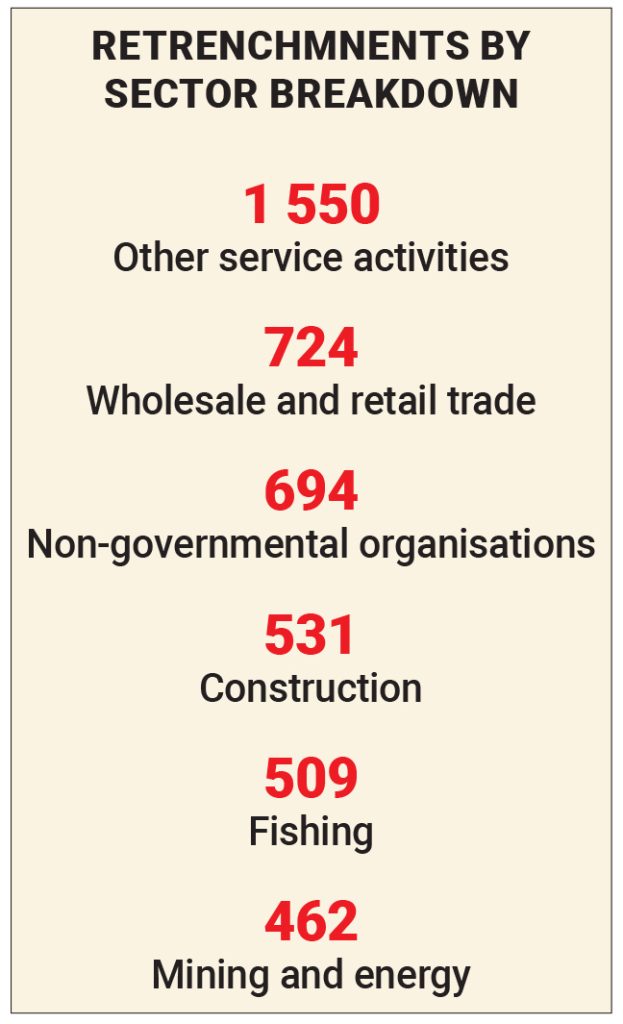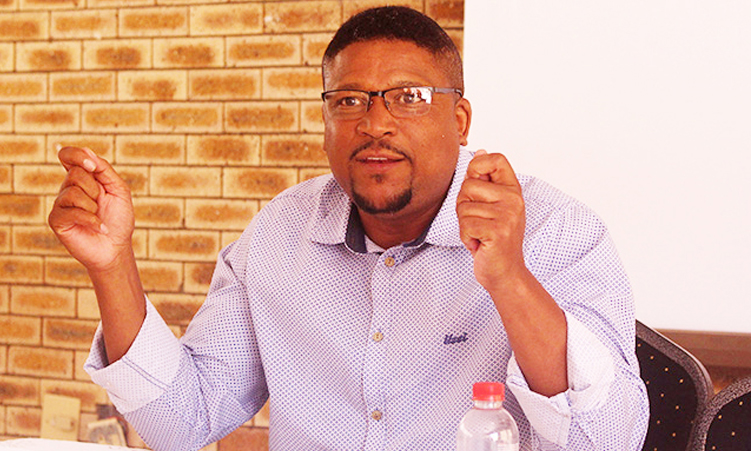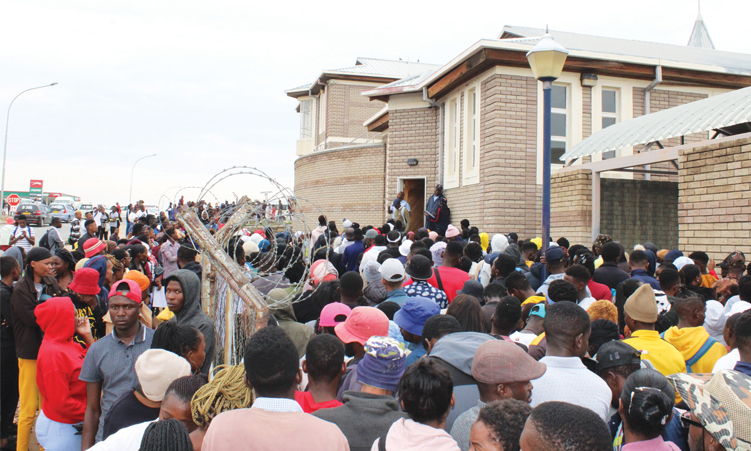
More than 5 600 workers have been retrenched from their jobs in 17 months.
This is reflected in the latest figures on employment in Namibia, released by the Ministry of Labour, Industrial Relations and Employment Creation last week.
While the figure shows a reduction, a full breakdown indicates that wholesale and retail trade sectors let go of 724 workers, non-governmental organisations 694 workers, construction 531 workers, fishing, 509 workers and mining and energy, 462 workers.
This is from 325 employers from all the different sectors.
Labour ministry executive director Lydia Indombo says 5 669 workers were retrenched between January 2023 and last month.
From January to December last year, the ministry recorded 3 793 job cuts from 217 employers.
Between January and July this year, 1 876 employees have lost their jobs from 108 employers.
During the pandemic, the retrenchment figures shot up to 14 452 workers laid off from 2020 to 2022.

The hardest hit sectors during that period were wholesale and retail trade (2 703); hospitality, tourism and food services (3 235); mining and energy (2 137); construction (971); as well as other service activities (1 498).
No retrenchments have taken place in the public sector since 2018.
Meanwhile, the ministry does not have the metrics or records that document the number of jobs created in the country.
“However, the ministry can provide placement of job seekers through the Namibia Integrated Employment Information System,” the executive director says.
Their system recorded 2 528 placements between January 2023 and this July.
The highest number of placements was recorded between last April and this March with 1 847 jobseekers finding work.
• January to March 2023: 352
• April 2023 to March 2024: 1 847
• April to July 2024: 329
Labour analyst Sydwill Scholtz on Monday said the current retrenchment statistics shows there are economic developments in areas which were previously a concern for the country.

“Despite these developments, we have not been able to overcome recent setbacks due to the lack of new jobs and employment opportunities for new market entrants,” he said.
The analyst said the unemployment rate of the country has increased year on year for the past few years, and this indicates that the developments and social benefits required for new job market entrants have not been catered to.
“Our working age population increased, but the number of available employment opportunities has not been commensurate with the demand required,” he said.
Scholtz said the recent cleaner position in the Kavango region saw many overqualified people applying for that role, simply to obtain employment and secure some level of income.
“In many households, the youth are left with no option other than to try and seek employment and make ends meet for the family dwelling, but with a youth unemployment rate as high as we see in the country, one could argue that this gives rise to other social issues and an increase in the crime rate in some instances,” Scholtz said.
Trade Union Congress of Namibia president Mahongora Kavihuha yesterday criticised the process of retrenchment, saying it is not used for the right purposes.
“These retrenchments cannot be directly linked to the issues of performance of the economy, nor labour market issues. It is purely variations of ensuring that they disadvantage the worker when he comes to the presentation,” he said.
“If you go to South Africa, retrenchment is handled by the productivity centre, where a company is required to come and present a comprehensive progress report to justify the retrenchment,” he said.
He said the retrenchment process has become a way of alleviating collective bargaining.

“When the company realised that these workers are organised by the union, they went on, they went on and retrenched because they don’t need to justify anything to anybody,” Kavihuha reasoned.
CHALLENGES
The ministry says the government lacks coordination in dealing with unemployment.
“Responsibilities for employment are split among too many government actors with insufficient coordination among them,” says Indombo.
Another problem is the low economic performance to absorb labour.
“The employment of the youth depends on the availability of investments that are directed at boosting the economic performance of a country and the creation of employment,” the executive director says.
The Bank of Namibia’s domestic economic outlook states that Namibia’s gross domestic product growth is projected to slow down in 2024, mainly due to subdued growth in the global economy, affecting demand for Namibia’s mineral exports and the prevailing drought conditions.
“The domestic growth projections for Namibia face substantial risks from global monetary policy tightening, adverse drought effects and weakened global commodity demand,” the outlook states. The central bank says the agriculture, forestry and fishing sector is expected to further contract this year, before improving slightly in 2025.
The agriculture, water, forestry and fishing sector retrenched 487 workers last year and 93 this year.
“Drought conditions threaten agricultural output, while strained water resources could disrupt various sectors.
Additionally, weakened global commodity demand, particularly for diamonds and zinc, could lead to a deterioration in the mining sector’s performance,” the bank says.
The mining and energy sector have let go of 462 employees since January 2023.

POTENTIAL MARKETS
Indombo has hopes that the development of the green hydrogen industry can lead to the growth of a new sector in the economy, creating jobs in research and development, engineering, manufacturing and project management.
“Green hydrogen projects may also stimulate the growth of supporting industries, such as renewable energy production, which can further boost employment opportunities, however, its impact may be realised after some time and not immediately,” Indombo says.
On the oil and gas sector, the ministry says the jobs can range from skilled technical positions to support roles in areas such as logistics, administration and environmental management.
“The oil and gas industry can contribute to economic growth and development, which may indirectly create employment opportunities in related sectors,” Indombo adds. Deloitte Namibia last week said the oil and gas market will produce 5 000 jobs during the construction and 7 000 during the production phase.
Lawmaker Inna Hengari highlights that the ministry continues to use the 2018 labour force survey results to determine labour market trends.
“Six years later, any rational Namibian can safely conclude that those numbers are much worse under the current economic climate. The first sign of a failing government is the lack of accurate and up-to-date statistics,” she says.
According to Hengari, the ministry has admitted to failing to adequately implement policies and programmes aimed at addressing unemployment.
“In other words, they are incapable of doing anything right, anything to help the dejected masses of our people.”
Hengari says 2 528 jobs are simply too few to address the unemployment crisis facing the country.
“There needs to be a complete overhaul of this ministry, including a new leadership youthful and eager to do the work. How can a ministry say they didn’t have enough money to create jobs and opportunities for the youth, while their audit reports indicate they spent half their development budget on paying salaries? Who is fooling who?”
Stay informed with The Namibian – your source for credible journalism. Get in-depth reporting and opinions for
only N$85 a month. Invest in journalism, invest in democracy –
Subscribe Now!






